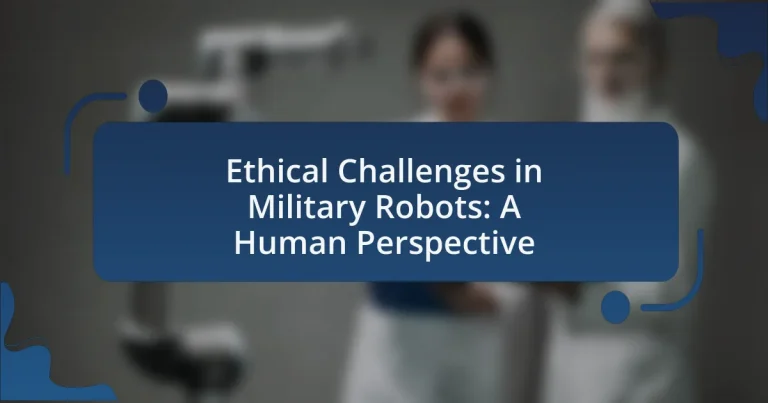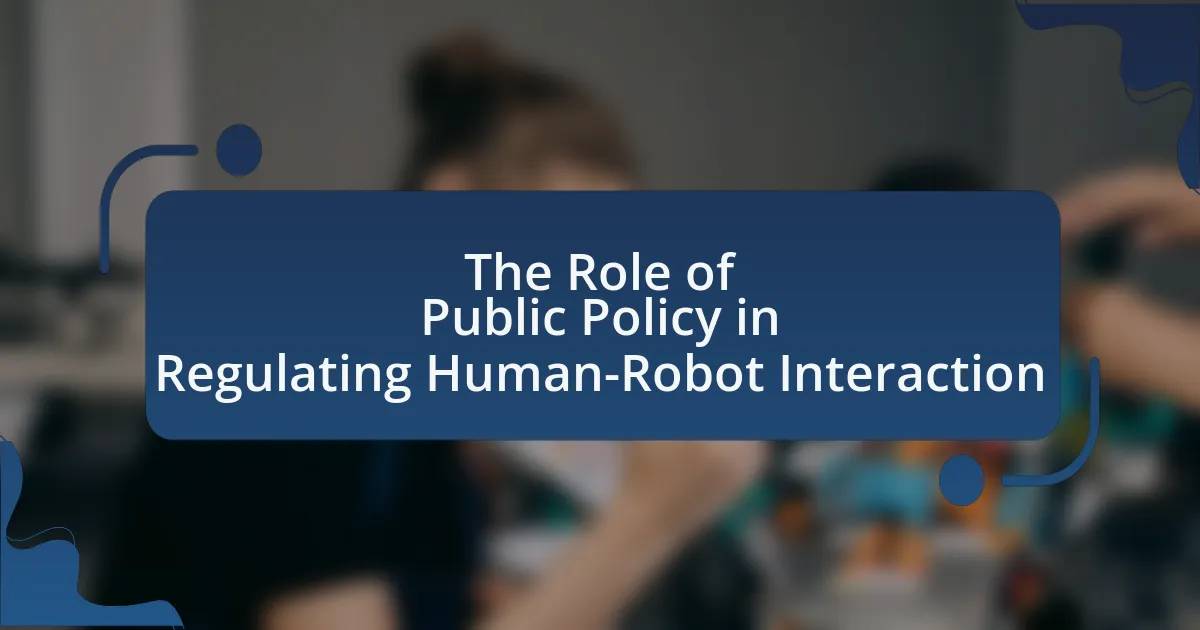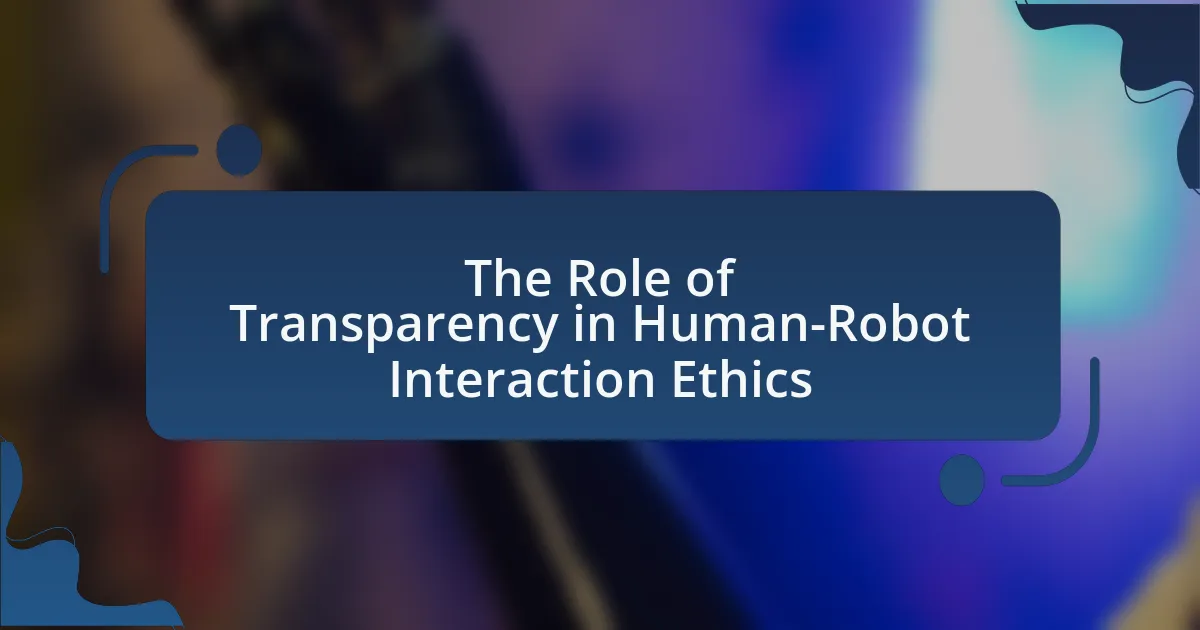The article focuses on the ethical challenges associated with military robots, emphasizing the importance of a human perspective in addressing issues such as accountability, decision-making autonomy, and the potential for dehumanization in warfare. It explores how ethical dilemmas arise from the delegation of lethal decision-making to machines, highlighting specific scenarios that illustrate these concerns. The article also discusses the influence of cultural perspectives on ethical considerations, the role of human operators in ensuring responsible use, and the implications of autonomous decision-making in combat. Additionally, it outlines strategies for mitigating ethical risks, the need for interdisciplinary collaboration, and the future prospects for ethical military robotics.
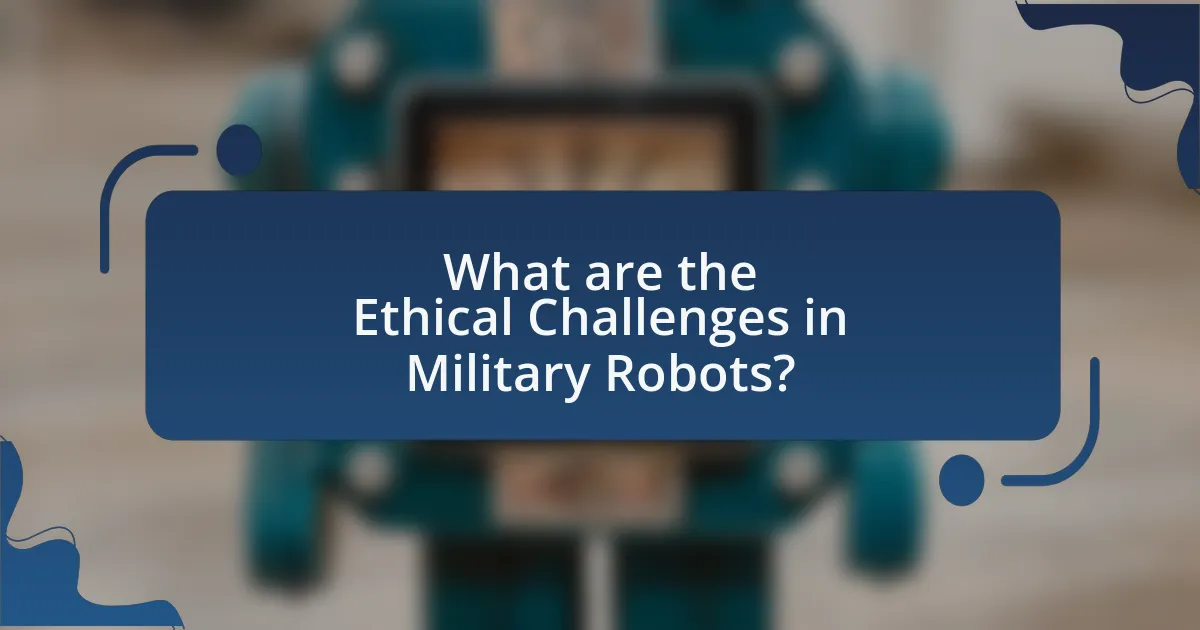
What are the Ethical Challenges in Military Robots?
The ethical challenges in military robots include accountability, decision-making autonomy, and the potential for dehumanization in warfare. Accountability issues arise because it is unclear who is responsible for actions taken by autonomous systems, especially in cases of civilian casualties. Decision-making autonomy raises concerns about machines making life-and-death choices without human oversight, which can lead to unintended consequences. Furthermore, the use of military robots can contribute to the dehumanization of conflict, as reliance on technology may desensitize soldiers and society to the realities of war, reducing empathy for affected populations. These challenges necessitate careful consideration and regulation to ensure ethical standards are upheld in military applications of robotics.
How do ethical challenges arise in the context of military robots?
Ethical challenges arise in the context of military robots primarily due to the delegation of lethal decision-making to machines. This delegation raises concerns about accountability, as it becomes unclear who is responsible for actions taken by autonomous systems in combat situations. For instance, incidents involving drones have highlighted issues of civilian casualties, where the lack of human judgment in targeting decisions can lead to unintended harm. Additionally, the potential for bias in algorithms used by military robots can exacerbate ethical dilemmas, as these biases may influence targeting and engagement decisions. The integration of military robots also raises questions about the moral implications of reducing human involvement in warfare, potentially desensitizing society to violence and conflict.
What specific scenarios highlight these ethical dilemmas?
Specific scenarios that highlight ethical dilemmas in military robots include autonomous drones making life-and-death decisions without human intervention, which raises concerns about accountability and moral responsibility. For instance, in 2016, a drone strike in Iraq conducted by an autonomous system resulted in civilian casualties, prompting debates about the ethical implications of allowing machines to determine targets. Another scenario involves the use of robotic soldiers in combat, where the potential for dehumanization and the erosion of moral judgment in warfare are significant concerns. These situations illustrate the complex interplay between technology, ethics, and human oversight in military operations.
How do cultural perspectives influence ethical considerations?
Cultural perspectives significantly influence ethical considerations by shaping the values, beliefs, and norms that guide moral reasoning within different societies. For instance, collectivist cultures may prioritize community welfare and social harmony, leading to ethical frameworks that emphasize group responsibility over individual rights. In contrast, individualistic cultures often focus on personal autonomy and rights, which can result in ethical considerations that prioritize individual decision-making. Research by Hofstede (1980) highlights how cultural dimensions, such as individualism versus collectivism, impact ethical decision-making processes across various contexts, including military ethics. This demonstrates that cultural backgrounds can lead to divergent ethical standards and practices, particularly in complex scenarios like the deployment of military robots, where differing cultural values may affect perceptions of accountability and moral responsibility.
Why is a human perspective crucial in addressing these challenges?
A human perspective is crucial in addressing ethical challenges in military robots because it ensures that moral considerations and societal values are integrated into decision-making processes. Human judgment is essential for evaluating the implications of autonomous systems, particularly in warfare, where actions can lead to loss of life and significant consequences. For instance, studies have shown that human oversight can mitigate risks associated with algorithmic bias and unintended harm, as seen in the 2016 incident involving a military drone that misidentified a target. By incorporating human perspectives, military operations can align more closely with ethical standards and humanitarian laws, ultimately fostering accountability and trust in the use of robotic systems.
What role do human operators play in the ethical deployment of military robots?
Human operators are crucial in ensuring the ethical deployment of military robots by making decisions that align with international humanitarian law and ethical standards. Their judgment is essential in assessing the context of military engagements, determining the proportionality of force, and minimizing civilian casualties. For instance, the U.S. Department of Defense emphasizes the importance of human oversight in autonomous weapon systems to maintain accountability and ethical responsibility in combat scenarios. This oversight helps prevent potential misuse of technology and ensures that military actions adhere to established ethical guidelines.
How can human emotions and biases affect decision-making in military robotics?
Human emotions and biases can significantly impact decision-making in military robotics by influencing the design, programming, and operational use of these systems. For instance, developers may unintentionally embed their own biases into algorithms, leading to skewed decision-making processes that favor certain outcomes over others. Research indicates that emotional responses, such as fear or aggression, can affect how operators interact with robotic systems, potentially leading to hasty or irrational decisions in high-stress situations. A study by the U.S. Army Research Laboratory found that emotional states can alter cognitive processing, which may result in suboptimal choices when deploying military robots in combat scenarios. This interplay between human emotions and biases highlights the need for careful consideration in the ethical development and deployment of military robotics.

What are the Implications of Autonomous Decision-Making in Military Robots?
The implications of autonomous decision-making in military robots include ethical concerns, accountability issues, and potential changes in warfare dynamics. Autonomous military robots can make real-time decisions without human intervention, which raises questions about moral responsibility when these systems cause harm. For instance, the use of drones in combat has already led to debates over civilian casualties and the lack of accountability for decisions made by machines. Furthermore, the integration of such technology may alter traditional combat strategies, potentially leading to an arms race in autonomous weaponry. The 2018 report by the United Nations Institute for Disarmament Research highlights these ethical challenges, emphasizing the need for clear regulations and oversight to ensure responsible use of autonomous systems in military contexts.
How does autonomy in military robots challenge traditional ethical frameworks?
Autonomy in military robots challenges traditional ethical frameworks by removing human judgment from critical decision-making processes in warfare. Traditional ethical frameworks, such as Just War Theory, emphasize the importance of human agency, accountability, and moral reasoning in combat situations. The deployment of autonomous systems, which can make life-and-death decisions without human intervention, raises concerns about the ability to adhere to these ethical principles. For instance, a study by the International Committee of the Red Cross highlights that autonomous weapons may struggle to comply with international humanitarian law, which requires distinguishing between combatants and non-combatants. This lack of human oversight can lead to unintended consequences, such as increased civilian casualties and diminished accountability for actions taken by these machines.
What are the potential consequences of autonomous actions in combat situations?
Autonomous actions in combat situations can lead to unintended civilian casualties and escalation of conflicts. The deployment of autonomous weapons systems, such as drones, raises ethical concerns regarding accountability and decision-making. For instance, a study by the International Committee of the Red Cross highlights that autonomous systems may struggle to comply with international humanitarian law, potentially resulting in violations that harm non-combatants. Additionally, the lack of human oversight can lead to errors in target identification, increasing the risk of collateral damage. These consequences underscore the need for stringent regulations and ethical guidelines in the development and use of military robots.
How can accountability be established for autonomous military robots?
Accountability for autonomous military robots can be established through clear legal frameworks that define responsibility for their actions. These frameworks should specify the roles of developers, operators, and military commanders in the decision-making process, ensuring that human oversight is maintained. For instance, the United Nations has discussed the need for regulations that hold parties accountable for the deployment and use of autonomous weapons systems, emphasizing the importance of traceability in decision-making processes. Additionally, implementing robust testing and validation protocols can ensure that these robots operate within ethical and legal boundaries, thereby reinforcing accountability.
What ethical guidelines are currently in place for military robots?
Currently, ethical guidelines for military robots emphasize accountability, proportionality, and discrimination in the use of force. These guidelines are informed by international humanitarian law, which mandates that military operations must distinguish between combatants and non-combatants, ensuring that any use of force is necessary and proportionate to the military advantage gained. Additionally, the United Nations has called for a framework to govern the development and deployment of autonomous weapons systems, highlighting the need for human oversight to prevent unlawful actions. These principles aim to mitigate risks associated with autonomous military technologies and ensure compliance with established legal and ethical standards.
How effective are existing regulations in addressing ethical concerns?
Existing regulations are moderately effective in addressing ethical concerns related to military robots. While frameworks such as the United Nations Convention on Certain Conventional Weapons provide guidelines, they often lack specificity regarding autonomous systems. For instance, the International Committee of the Red Cross emphasizes the need for compliance with international humanitarian law, yet many existing regulations do not adequately cover the complexities of AI decision-making in combat scenarios. This gap highlights the necessity for more robust and detailed regulations that can effectively manage the ethical implications of deploying military robots.
What gaps exist in current ethical frameworks for military robotics?
Current ethical frameworks for military robotics lack comprehensive guidelines addressing accountability for autonomous decision-making, particularly in lethal scenarios. These frameworks often do not specify who is responsible for actions taken by robots, leading to ambiguity in legal and moral accountability. Additionally, existing frameworks frequently overlook the implications of bias in algorithms, which can result in discriminatory targeting or decision-making processes. Furthermore, there is insufficient consideration of the psychological impact on human operators and the potential for desensitization to violence. Lastly, the frameworks do not adequately address the need for transparency in the development and deployment of military robotics, which is essential for public trust and ethical oversight.
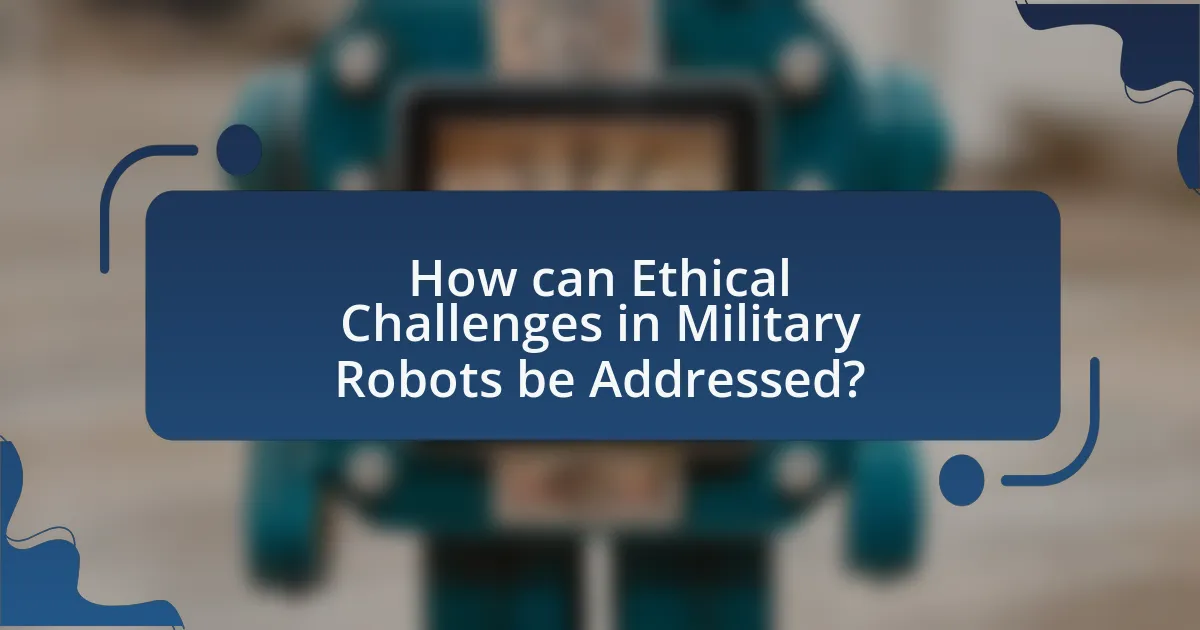
How can Ethical Challenges in Military Robots be Addressed?
Ethical challenges in military robots can be addressed through the establishment of clear guidelines and regulations that govern their use. These guidelines should prioritize human oversight, ensuring that decisions involving lethal force remain under human control, as emphasized by the United Nations’ discussions on autonomous weapons systems. Additionally, incorporating ethical training for military personnel and developers can foster a culture of responsibility and accountability. Research indicates that frameworks like the Asilomar AI Principles advocate for transparency and collaboration among stakeholders, which can further mitigate ethical concerns. By implementing these measures, the military can navigate the complexities of deploying robotic systems while upholding ethical standards.
What strategies can be implemented to mitigate ethical risks?
To mitigate ethical risks associated with military robots, organizations can implement strategies such as establishing clear ethical guidelines, conducting thorough risk assessments, and ensuring accountability through oversight mechanisms. Clear ethical guidelines provide a framework for decision-making, helping to align military operations with moral standards. Thorough risk assessments identify potential ethical dilemmas and inform the development of protocols to address them. Accountability mechanisms, such as independent review boards, ensure that actions taken by military robots are subject to scrutiny, thereby promoting responsible use. These strategies are supported by research indicating that structured ethical frameworks can significantly reduce the likelihood of ethical breaches in military applications.
How can training for military personnel improve ethical decision-making?
Training for military personnel can significantly improve ethical decision-making by providing structured frameworks and scenarios that enhance moral reasoning. Such training often includes simulations and case studies that expose personnel to complex ethical dilemmas, allowing them to practice decision-making in a controlled environment. Research indicates that programs focusing on ethical training can lead to better outcomes in real-life situations, as personnel become more adept at recognizing ethical issues and considering the implications of their actions. For example, a study published in the Journal of Military Ethics found that military ethics training improved the ability of soldiers to navigate moral challenges, leading to more responsible and accountable behavior in the field.
What role does public discourse play in shaping ethical standards?
Public discourse plays a crucial role in shaping ethical standards by facilitating dialogue among diverse stakeholders, including policymakers, ethicists, and the general public. This dialogue helps to identify societal values and concerns regarding ethical issues, such as the use of military robots. For instance, discussions surrounding military robotics often highlight the moral implications of autonomous decision-making in combat, prompting public scrutiny and influencing legislative frameworks. Research indicates that public engagement can lead to more informed and democratic decision-making processes, as seen in the debates surrounding the ethical use of artificial intelligence in warfare, which have shaped guidelines and policies in various countries.
What best practices should be followed in the development of military robots?
Best practices in the development of military robots include ensuring compliance with international humanitarian law, prioritizing human oversight, and incorporating robust safety measures. Compliance with international humanitarian law is essential to prevent unlawful harm to civilians and ensure ethical engagement in conflict. Prioritizing human oversight allows for critical decision-making to remain with trained personnel, reducing the risk of autonomous errors. Incorporating robust safety measures, such as fail-safes and thorough testing protocols, mitigates risks associated with malfunctioning systems. These practices are supported by guidelines from organizations like the International Committee of the Red Cross, which emphasizes the importance of accountability and ethical considerations in military technology.
How can interdisciplinary collaboration enhance ethical considerations?
Interdisciplinary collaboration can enhance ethical considerations by integrating diverse perspectives and expertise, which leads to more comprehensive ethical frameworks. For instance, combining insights from engineering, ethics, law, and social sciences allows for a holistic understanding of the implications of military robots. Research by Lin et al. (2017) in “Robot Ethics 2.0” highlights that such collaboration can identify potential ethical dilemmas early in the design process, ensuring that ethical standards are embedded in technology development. This approach not only addresses technical challenges but also considers societal impacts, thereby fostering responsible innovation in military robotics.
What are the key factors to consider in the design of ethical military robots?
The key factors to consider in the design of ethical military robots include accountability, transparency, and adherence to international humanitarian law. Accountability ensures that there is a clear chain of responsibility for the actions taken by military robots, which is crucial for ethical decision-making in combat scenarios. Transparency involves making the decision-making processes of these robots understandable to human operators and stakeholders, allowing for scrutiny and trust. Adherence to international humanitarian law ensures that military robots operate within the legal frameworks governing armed conflict, which includes principles such as distinction, proportionality, and necessity. These factors collectively contribute to the ethical deployment of military robots, as evidenced by discussions in reports from organizations like the International Committee of the Red Cross, which emphasize the importance of these principles in maintaining ethical standards in warfare.
What are the future prospects for ethical military robotics?
The future prospects for ethical military robotics include increased integration of ethical frameworks in design and deployment, driven by advancements in artificial intelligence and international regulations. As military organizations recognize the importance of ethical considerations, there is a growing emphasis on developing autonomous systems that adhere to humanitarian laws and ethical standards. For instance, the United Nations has initiated discussions on regulating lethal autonomous weapons systems, highlighting the need for accountability and ethical guidelines. Furthermore, research indicates that incorporating ethical decision-making algorithms can enhance the operational effectiveness of military robots while minimizing unintended harm, as seen in studies conducted by institutions like the Massachusetts Institute of Technology. These developments suggest a trajectory toward more responsible and ethically aligned military robotics in the future.
How might advancements in technology influence ethical challenges?
Advancements in technology significantly influence ethical challenges by introducing complex dilemmas regarding autonomy, accountability, and decision-making in military robots. For instance, the development of autonomous weapon systems raises questions about the moral implications of machines making life-and-death decisions without human intervention. Research from the International Committee of the Red Cross highlights that such technologies could lead to violations of international humanitarian law if not properly regulated. Additionally, the integration of artificial intelligence in military operations complicates accountability, as it becomes unclear who is responsible for actions taken by autonomous systems. This evolving landscape necessitates ongoing ethical discourse to address the implications of these technological advancements on warfare and human rights.
What ongoing research is needed to address emerging ethical issues?
Ongoing research needed to address emerging ethical issues in military robots includes the development of frameworks for accountability, transparency, and decision-making processes in autonomous systems. This research is crucial as it aims to establish ethical guidelines that govern the use of military robots, ensuring they operate within acceptable moral boundaries. For instance, studies like “Ethics of Autonomous Military Robotics” by Paul Scharre highlight the necessity for clear accountability mechanisms to prevent misuse and unintended consequences of robotic systems in warfare. Additionally, research into the psychological impacts on human operators and the implications of delegating lethal decision-making to machines is essential, as outlined in the work “The Ethics of Military Robots” by Ryan Calo. These studies emphasize the importance of understanding the ethical ramifications of deploying autonomous technologies in combat scenarios.
What practical steps can military organizations take to ensure ethical practices?
Military organizations can ensure ethical practices by implementing comprehensive training programs focused on ethical decision-making and the responsible use of military robots. These programs should include scenario-based training that emphasizes the moral implications of using autonomous systems in combat, fostering a culture of accountability among personnel. Additionally, establishing clear guidelines and protocols for the deployment of military robots, which align with international humanitarian law, is essential. Regular audits and assessments of robotic systems can further ensure compliance with ethical standards. Research indicates that organizations with robust ethical training and oversight mechanisms are more likely to adhere to ethical practices, as seen in the U.S. military’s integration of ethical considerations into its operational framework.
